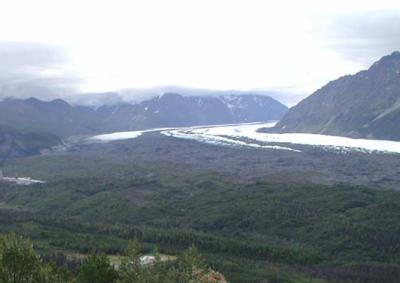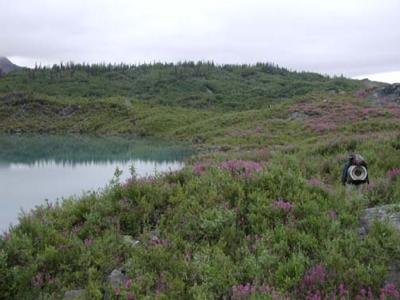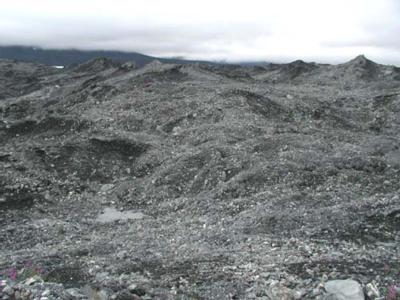31 July, 2000
July 31, 2000
Matanuska Glacier, Alaska
The beautiful weather we had yesterday remained to provide a nice clear
sky all night long. For the first time I was able to spot a few stars
although it’s still too light to see any but the brightest. We had not
had such a clear night since the first week I was in camp. The distant
snow capped peaks that are visible up Glacier Creek were very bright and
scenic as the sun slowly dipped over the horizon. The scene was one that
you wish could be preserved and experienced over and over. Although it
doesn’t get totally dark, the absence of the sun always serves to cool
things down whether it’s from the setting of the sun or daytime cloud
cover. By morning the air felt quite cool and a good frost was on the
stove as I made my morning coffee. By mid-morning we were off to town
for yet another day of grocery shopping, laundry and showers.
Ben stayed behind and set up the ISCOs for yet another dye experiment.
This time we decided to go farther up the glacier and pour into the
moulin that we originally used with our salt experiments. We have gotten
repeatable results with our first series of dye tests and now it’s time
to build on those results a bit with a new experiment. It will be
interesting to see what comes out of the samples when we analyze them
tomorrow.
In many of the pictures I’ve included in these journals it has been
obvious that there is a lot of rocks and debris on the surface of the
glacier here. The Matanuska is a bit unusual in the extent and spreading
of debris near the terminus. This debris which includes large boulders,
gravel and sand is called a moraine. There are several basic types of
moraines.
A “lateral moraine” runs parallel to the glacier and lines both sides of
it. They are generally created by two processes: 1) a build up of debris
between the sides of the glacier and the bases of the surrounding
mountains from rockslides off the mountain slopes and 2) abrasion of
sediment and plucking of rocks and boulders from the side valley walls
by the glacier itself.
A “medial moraine” is created whenever two ice flows merge. As the
glaciers meet, a pile of debris from each glacier’s lateral moraine is
pushed up in between them. These are easily recognized in pictures or
from the air as a ribbon of black material running down the middle of
the glacier. There can be more a number of medial moraines on a glacier
if several flows come together at different places along the path of the
glacier.
An “end or recessional moraine” is created at the terminus as the ice
melts and deposits rocks and debris. These can form if the terminus of a
glacier remains essentially in the same place for a long period of time.
If this moraine is the farthest down the valley it is called the
“terminal moraine”. The terminal moraine of the Matanuska Glacier is
near Elmendorf Air Force base near Anchorage and was produced beyond the
confluence of the Matanuska and Knik Glaciers about twelve to fourteen
thousand years ago. There are no distinct recessional moraines between
this terminal moraine and about four miles from the present terminus.
This suggests to geologists that it retreated rapidly back to near the
present location. Currently the glacier is receding at about ten meters
per year.
Marvin Giesting

You can see a large and a small medial moraine as well as the lateral moraines in this picture. The medial moraines spread out near the terminus of this glacier. The green area in the foreground is stagnant ice and supports wooded vegetation. As you move across the moraine you get into the active ice which has many flowers growing near the stagnant ice. Still farther across the debris is too rocky or thin to support any vegetation.

In this area near North Vent you can see the forested stagnant ice as well as flowers growing on the active ice.

It looks like a moonscape out on the moraines. You can barely see the white ice off in the distance.

The supraglacial debris thins out more and more as you move a cross the moraine toward the englacial (white) ice. Notice the rough angular edges to this material.
Contact the TEA in the field at
.
If you cannot connect through your browser, copy the
TEA's e-mail address in the "To:" line of
your favorite e-mail package.
|
